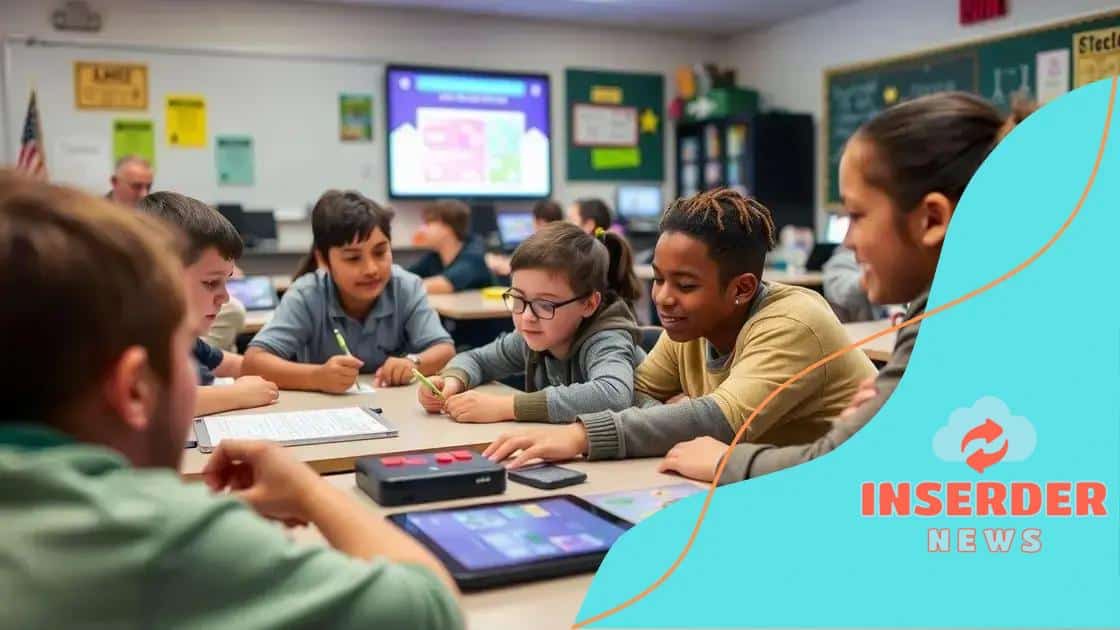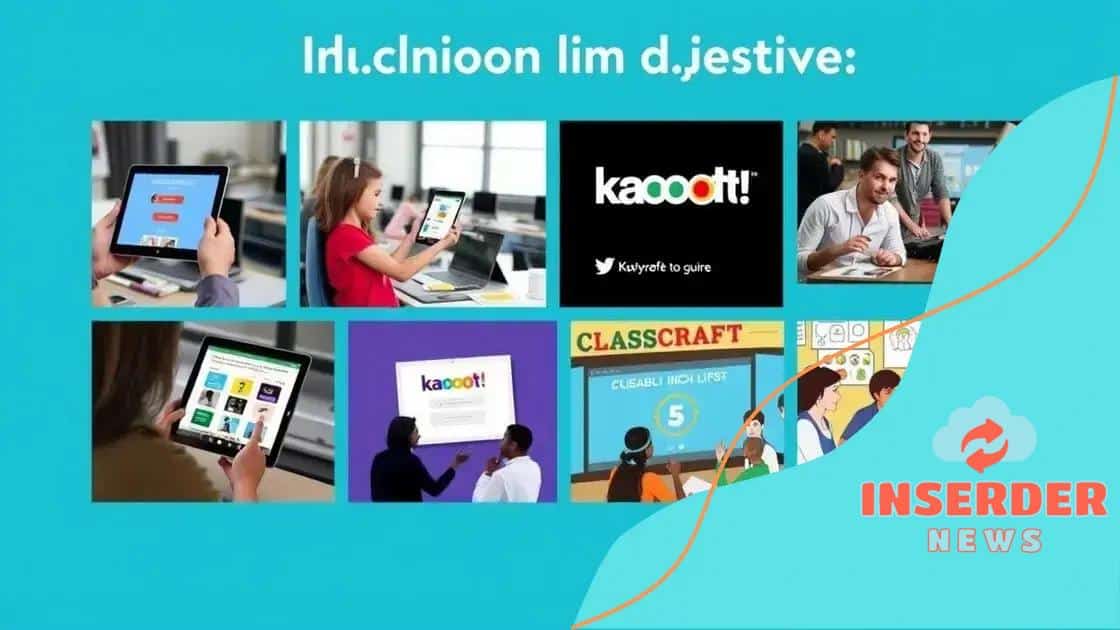The impact of gamification on student learning outcomes

The impact of gamification on student learning outcomes enhances engagement and motivation, leading to improved academic performance through interactive and personalized learning experiences.
The impact of gamification on student learning outcomes is reshaping how we view education. By incorporating game-like elements into learning, educators can engage students in exciting ways. Have you ever wondered how this trend could change your learning experience?
Understanding gamification in education
Understanding gamification in education is vital for enhancing student engagement. It combines fun and learning, making education exciting.
What is Gamification?
Gamification involves using game elements in non-game contexts, especially in education. This approach includes rewards, challenges, and interactive elements that motivate students.
Benefits of Gamification
When gamification is applied effectively, it offers numerous advantages:
- Increased Motivation: Students are more inclined to participate when they see immediate rewards.
- Enhanced Retention: Learning becomes memorable through game-like interactions.
- Immediate Feedback: Students receive instant responses to their actions, helping them learn from mistakes.
Additionally, gamification encourages collaboration among students. They often team up to tackle challenges, promoting social skills and teamwork. The sense of competition can further ignite a passion for learning, leading to improved outcomes.
Furthermore, integrating gamification allows teachers to track progress easily. By analyzing game metrics, educators can identify areas where students excel or struggle, tailoring their approach accordingly.
This dynamic method is evolving rapidly and can take many forms, from simple quizzes with points to complex simulations. The key is to create a balanced learning environment where gamification supports educational goals without overshadowing them.
The role of motivation in learning
The role of motivation in learning is a key factor that shapes educational experiences. When students feel motivated, they engage more with the material and achieve better results.
Types of Motivation
Motivation can be categorized into two main types: intrinsic and extrinsic. Understanding both can help educators create effective learning environments.
- Intrinsic Motivation: This arises from within the student. They may find joy in learning itself or be curious about a subject.
- Extrinsic Motivation: This comes from outside factors, such as rewards, grades, or praise. While helpful, it may not foster long-term engagement.
Fostering motivation in students can lead to deeper understanding and retention of knowledge. When students are excited about their learning, they are more likely to explore topics beyond the classroom. Allowing students to pursue their interests can also boost their motivation significantly.
Additionally, setting specific, achievable goals for students can enhance their sense of accomplishment. When they achieve these goals, it can create a positive feedback loop, encouraging them to set and pursue new challenges.
Teachers can facilitate motivation by creating engaging lessons that connect learning to real-life applications. For example, using relatable scenarios helps students see the value in what they are learning. Collaborating with peers on projects can also enhance motivation through social interaction.
Case studies of gamification success

Case studies of gamification success provide valuable insights into how this approach can improve learning outcomes. Many schools and organizations have adopted gamification to enhance student engagement and achievement.
Example 1: Duolingo
Duolingo is a popular language-learning platform that uses gamification effectively. It offers rewards such as points, levels, and badges to encourage users to practice regularly. The interactive exercises are designed like games, making the learning experience enjoyable.
Example 2: Kahoot!
Kahoot! is another example where gamification has transformed learning. Instructors can create fun quizzes that students can participate in using their devices. This competitive element keeps students motivated and eager to participate, enhancing their retention of information.
Example 3: Classcraft
Classcraft turns the classroom into a role-playing game. Students work together as characters with special powers to solve quests. This approach fosters teamwork and collaboration while making learning more dynamic. The game elements encourage students to achieve academic goals and support one another.
These case studies highlight that when gamification is implemented well, it can lead to improved performance and a more engaging learning environment. However, successful adoption requires careful design to ensure educational goals are met.
Schools that integrate gaming elements with educational content create more meaningful learning experiences. Research shows that students are more likely to participate actively when they feel they are part of an interactive game rather than just a traditional classroom setting.
Challenges in implementing gamification
Challenges in implementing gamification in education are important to consider for successful outcomes. While the benefits can be substantial, various obstacles may arise during the process.
Lack of Understanding
One major challenge is the lack of understanding among educators about how to effectively use gamification. Not all teachers are trained in game design principles or how to apply them in a classroom setting. This can lead to poorly planned gamified experiences that do not meet educational goals.
Student Engagement
Another issue is ensuring student engagement. Not every student is motivated by the same game elements. Some may thrive on competition, while others prefer collaboration. This diversity in student preferences can make it tough to design a one-size-fits-all gamified approach.
- Balancing Competition: While competition can energize some students, it may stress others and discourage participation.
- Keeping it Fun: Maintaining students’ interest over time can be challenging. If gamified elements become repetitive or feel like extra work, students may disengage.
- Resource Allocation: Implementing gamification effectively requires time, tools, and training for educators, which can strain school resources.
Moreover, technology issues can arise as well, especially in schools with limited access to computers or tablets. If gamification relies heavily on technology, students without adequate devices may be left out.
Lastly, measuring the effectiveness of gamification can pose a challenge. It can be difficult to quantify improvements in learning outcomes due to various factors affecting student performance.
Future trends in educational gamification
Future trends in educational gamification are poised to transform how students learn. As technology evolves, several exciting developments are emerging.
Increased Use of AI
Artificial intelligence (AI) is becoming central in personalized gamified learning experiences. AI can analyze student data to tailor challenges and rewards specifically suited to each learner’s needs. This customization enhances the effectiveness of gamification by making learning more relevant and engaging.
Virtual and Augmented Reality
Virtual reality (VR) and augmented reality (AR) are also set to play a significant role in educational gamification. These technologies create immersive environments where students can learn through exploration and interaction. For example, students might solve problems in a virtual lab or explore historical events in a 3D space.
- Immersive Learning Experiences: Students can interact with content in a more engaging way, making complicated subjects easier to understand.
- Collaborative Gameplay: Group activities in virtual environments promote teamwork and communication skills.
- Real-World Applications: Simulations can prepare students for real-world scenarios, enhancing their practical knowledge.
Moreover, gamification will likely integrate with learning management systems (LMS), providing seamless experiences for tracking progress and achievements. This integration will allow educators to monitor student engagement and adapt their teaching strategies efficiently.
Adaptive learning technologies, combined with gamification, will also lead to more interactive lessons. Students will receive instant feedback and can adjust their learning paths based on their performance. This flexibility encourages students to take ownership of their learning.
FAQ – Frequently Asked Questions about Gamification in Education
What is gamification in education?
Gamification in education refers to the use of game elements and principles, such as rewards and challenges, to enhance student engagement and learning.
How can gamification improve student motivation?
Gamification enhances motivation by providing immediate rewards and feedback, which encourages students to participate actively and take ownership of their learning.
What are some challenges associated with implementing gamification?
Challenges include lack of understanding among educators, varying student engagement levels, resource allocation, and difficulties in measuring effectiveness.
What future trends can we expect in educational gamification?
Future trends include increased use of AI for personalized learning, the integration of VR and AR for immersive experiences, and seamless inclusion in learning management systems.






